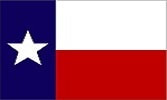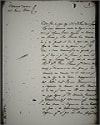The Battle of Velasco
|
Shortly after it was built, the original Fort Velasco was the site of the Battle of Velasco primarily in the overnight period of 26- to 27-Jun-1832, followed by several days of negotiation. This small battle ended with the peaceful capitulation of the Mexican forces occupying the fort, and they were allowed to return to Mexico. The final agreement indicated that Lt. Colonel Domingo de Ugartechea and his troops were to be transported by sea to Matamoros, but this did not happen since a seaworthy ship was not available, so they instead traveled overland to Matamoros.
The battle itself arose due to conflict between Mexican and Texian forces in the Anahuac Disturbances of 1832. In an effort to take at least two cannon from Brazoria to besiege Fort Anahuac via the schooner Brazoria, passage by the Brazos fort was refused by its commander, Domingo de Ugartechea (pictured). The Texians' plan then became a forced passage in the middle of the night. The Brazoria was to sail on the evening of 26-Jun-1832 commanded by William J. Russell (pictured), stopping abreast of the fort to engage in an artillery exchange, and causing the Mexican forces to retreat into the fort. During this time, Texian land forces were to stealthily encircle the fort and attack at dawn, with groups under John Austin (pictured) and Henry Smith occupying quickly-built trenches north of the fort, and also a group under Henry S. Brown occupying existing debris along the beach. Things did not go as planned, as the land forces were discovered in the darkness and the battle began, and the schooner became disabled and aground. A stalemate occurred, but the Mexican forces surrendered the following day primarily due to lack of ammunition. |
|
Not long after the Battle Of Velasco, Terán committed suicide on 3-Jul-1832 behind a church in Padilla, Tamaulipas near his new headquarters, despondent over Mexican politics (since he had sided with the unsuccessful centralist regime that had just fallen to Santa Anna) and his belief that Texas was lost.
The 1832 fort itself with arms, supplies and also the wounded were enumerated after the attack listing a brass 8-pound cannon and an “iron swivle” gun, with a slightly-different version listing a brass long nine pounder on a carriage, and an iron swivel (gun) on a block. The items were returned to Gen. Jose Antonio Mexía who arrived with five ships and 400 men (and Stephen F. Austin) at the mouth of the Brazos on 16-Jul-1832, in what has been termed Mexía’s Expedition. The Texians received Mexía warmly, and convinced him that they were not rebels against Mexico, but (like Mexía) were supporters of Santa Anna and the Mexican Constitution. Indeed, one part of the effort to convince Mexía was an evening “public dinner and ball” held at Brazoria in honor of Santa Anna (not present) on 22-Jul-1832. In a special issue, the Texas Gazette publishes many documents, such as the articles of capitulation with Ugartechea, John Austin's report and inventory, and also the agreements with Mexía (left). |
As with the period of building the fort, some of the details about the battle and its aftermath can be found in various letters and dispatches. Another excellent source is the book "Thunder On The Brazos" by Mary D. Boddie. One especially significant document is the lengthy "after action" report made by Ugartechea himself on 1-Jul-1832 (first link below). Click below on the thumbnails for copies of primary documents (not readily available elsewhere), or the "black buttons" for an attempt at transcription and translation, which each tell a part of this story, contained in documents now found in the ....
Béxar Archives and the Samuel May Williams Collection
Courtesy of the Dolph Briscoe Center of American History, University of Texas at Austin
and the Galveston & Texas History Center, Rosenberg Library (Galveston, Texas)
A narrative report that discusses all of the research on
the several Forts Velasco is available at the link below:
<<< Creation of the First Fort Velasco < click for other pages > Weapons at the Battle of Velasco >>>
Background wallpaper is from 1834 version of "Map of the State of Coahuila and Texas" by William Hooker of New York
Background wallpaper is from 1834 version of "Map of the State of Coahuila and Texas" by William Hooker of New York























